Introduction
The UMF® Manuka honey brand, as represented by AMHA, is valued at NZ$11million per annum to the industry. The strength of this industry is also supported by the UMF® trademark, which has been registered in 46 key trading countries. In addition, the highly regarded IANZ Accreditation of the UMF test method gives formal, international recognition of the UMF test method.
Following, are the factual details of the establishment of AMHA and the beginnings of UMF®.
How it all began
Waikato-based Honey producer Margaret Bennett was present at the establishment of AMHA, and has a clear recollection of what happened:
“We had first met with TRADENZ Hamilton in 1995, as we were seeking advice on how to set apart and market the type of Manuka honey that has the special non-peroxide antibacterial activity. Subsequent investigations made as a result of those meetings, demonstrated to TRADENZ Hamilton there was a clear need for a structure, name and standards.”
The Catalyst Issue
Judith Saunders from TRADENZ Hamilton saw the need to get industry standards and to name the activity – at that time the honey which had non-peroxide activity was known simply as Active Manuka Honey. The word “Active” was a very loose term that could be applied to any activity in honey and therefore could not be registered to give legal protection. A new name had to be found and established. Judith Saunders called a meeting of all known interested parties which included producers, marketers, and researchers.
The vision was to represent the whole honey industry and offer protection for the consumer.
The first TRADENZ meeting was held on 13th March 1997. The second was held on 8th May 1997. Both of these meetings were at the TRADENZ Hamilton office.
Dedicated Industry Group Formed
Out of the TRADENZ meetings an industry group was formed named the Active Manuka Honey Industry Group (AMHIG). A steering committee was appointed and charged with the responsibility of investigating a name for the activity, how best to protect that name, and setting standards. Bill Floyd was approached to act as co-ordinator for the steering committee. It was in this capacity that Bill Floyd and Peter Molan coined the mark UMF: Unique Manuka Factor.
Credit where it’s Due
Judith Saunders sent out minutes of the first meeting and enclosed with them a letter from Bill Floyd. The minutes stated in the “Background” section that the meeting had come about because of enquiries from a producer (Bill and Margaret Bennett). The footnote of Bill Floyd’s letter congratulates Judith on making the meeting happen. He says “I wish I had taken the initiative and could be taking the credit for it all!”
UMF Registered
In May 1998 at a beekeeper’s Field-day held at Paengaroa, Dr Peter Molan announced the name UMF®. He said that it had been registered by the group as a trademark and that it stood for Unique Manuka Factor. The purpose of it being registered as a trademark was to control its use and enforce standards. This announcement was the start of the process of gaining acceptance of UMF® as a brand. Credit is also given to others, especially John Bassett (original Chairman) and Mike Stuckey (original Secretary), as they helped the organisation to grow and develop for the first few years.
Timeline of Progress
The years since 2002, under the leadership of initially, Kerry Paul and then Moira Haddrell, have seen very rapid progress:
- AMHIG became an incorporated society known as the Active Manuka Honey Association (AMHA)
- John Bassett, who had held the trademark UMF® in trust (as AMHIG was not a legal trading entity) then handed the mark over to AMHA
- Brand and Project Managers were appointed
- Collection of annual levies was set up in order to fund AMHA for its role of protection, research and promotion
- Development of the AMHA website, promotional material and UMF® Certificates
- Rapid growth in membership led to the number of licensees doubling
- Trademark rules and use implemented and monitored with all licensees
- Major legal success of prosecution of not-true-to-label producer
- Successful market audits of NZ and Singapore were first conducted in 2004
- October 2009, funding for IANZ Accreditation for NZLABS.


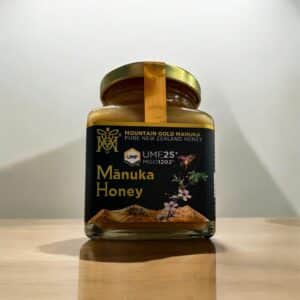 UMF® 25+ (MGO 1202+) Manuka Honey 250g
UMF® 25+ (MGO 1202+) Manuka Honey 250g
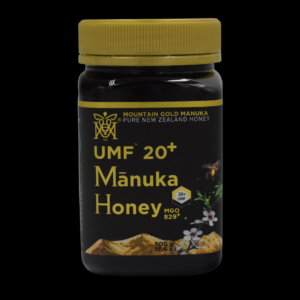 UMF® 20+ (MGO 829+) Manuka Honey 500g
UMF® 20+ (MGO 829+) Manuka Honey 500g
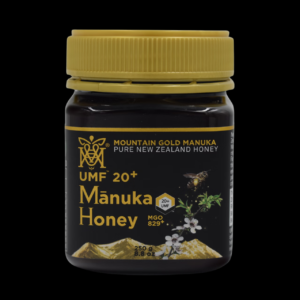 UMF® 20+ (MGO 829+) Manuka Honey 250g
UMF® 20+ (MGO 829+) Manuka Honey 250g
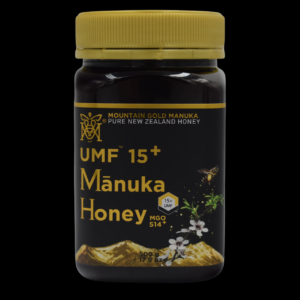 UMF® 15+ (MGO 514+) Manuka Honey 500g
UMF® 15+ (MGO 514+) Manuka Honey 500g
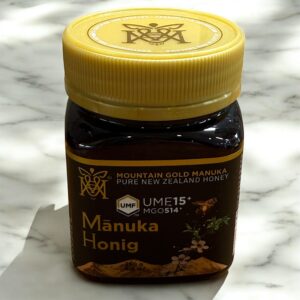 UMF® 15+ (MGO 514+) Manuka Honey 250g
UMF® 15+ (MGO 514+) Manuka Honey 250g